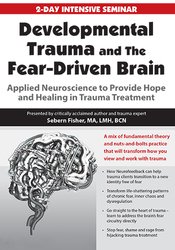

You’ve looked into the eyes of traumatized clients and seen absolute fear. For you, working with trauma isn’t about a paycheck.
You care about outcomes.
Abuse, abandonment, neglect and violent trauma. Experienced at an early stage of development, it sets up a life-shattering pattern of chronic fear, inner chaos and dysregulation. It disrupts the development of the brain, disorders the capacity for attachment, and distorts your clients’ relationships with themselves and others.
In therapy, an over-active amygdala sets off the stress response again and again, keeping clients from making real progress in traditional talk-based therapies. Without addressing the brain’s fear circuitry directly, therapeutic progress can prove elusive.
Sebern Fisher “gets” trauma. She knows what the fear-driven brain is all about. And insights and guidance from her groundbreaking work in the field of trauma and neurofeedback can provide you with a whole new paradigm to achieve the positive treatment outcomes you want for your clients.
In his foreword to Dr. Fisher's critically acclaimed book Neurofeedback in the Treatment of Developmental Trauma, internationally recognized trauma expert Bessel van der Kolk, MD
| File type | File name | Number of pages | |
|---|---|---|---|
| Manual - Developmental Trauma and Fear-Driven Brain (8.07 MB) | 76 Pages | Available after Purchase |

Sebern Fisher, MA, LMH, BCN, is an interntionally-recognized expert on the use of neurofeedback in the treatment of deveopmental trama and best-selling author of Neurofeedback in the Treatment of Developmental Trauma: Calming the Fear-Driven Brain. She has been working with traumatized people for over 35 years and has integrated Neurofeedback and psychotherapy in her treatment of developmental trauma in adults and adolescents for the past 20 years.
Prior to adopting Neurofeedback, Sebern was the clinical director of a residential treatment program for severely disturbed adolescents for 15 years. While there, she introduced the understanding of the impact of attachment rupture and was the first to implement DBT in a residential setting.
Sebern consults and trains on the integration of Neurofeedback and therapy, nationally and internationally.
Speaker Disclosures:
Insecure Attachment and Developmental Trauma
The Fear-Driven Brain: Adverse Childhood Experiences and Trauma
Arousal, Reactivity, and Affect Dysregulation in Trauma
Stop Letting Fear, Shame and Rage Hijack Trauma Treatment
Fear as the Core of Transference: Handle Transference and Counter-Transference Issues
Neurofeedback as Applied Neuroscience in Psychotherapy: Essentials and Assessment
Quiet Fear with Neurofeedback: Integrate Neurofeedback into Trauma Treatment
Who Will I Be When I’m Not Afraid: Working with the Fear-Bound Identity
Please wait ...